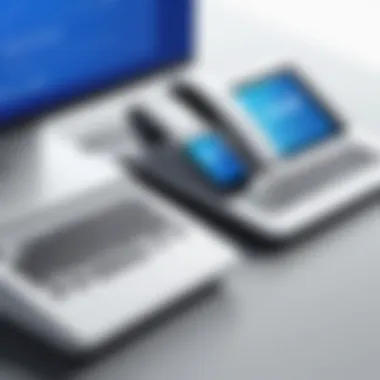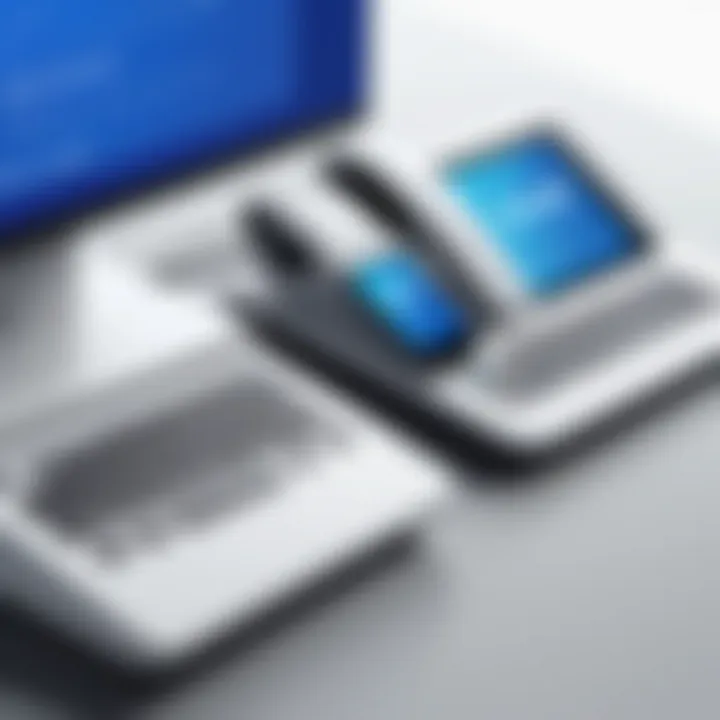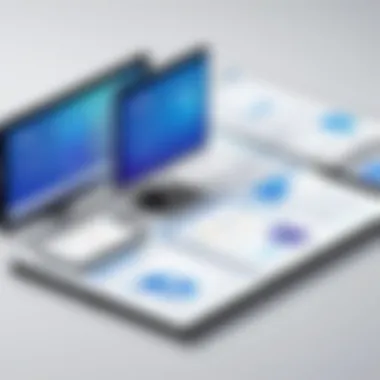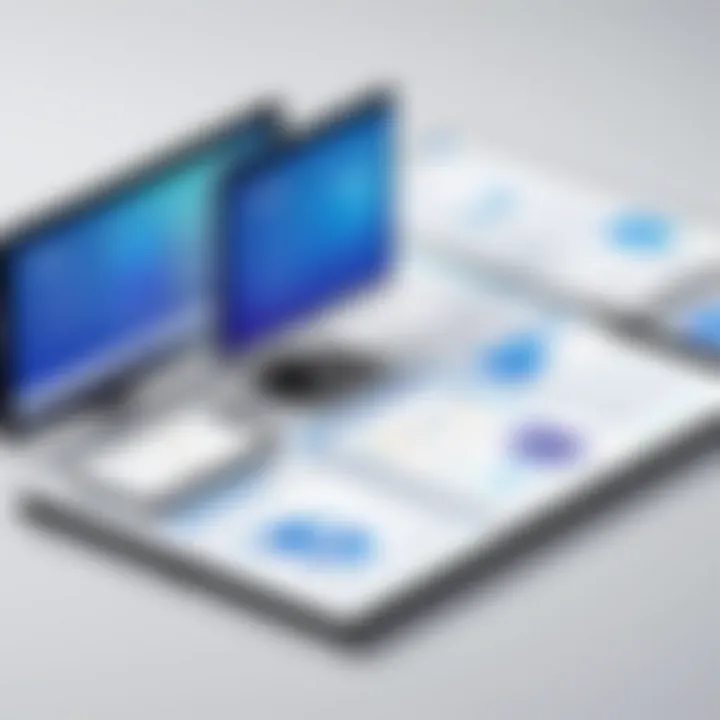Integrating eFax with Google Services for Seamless Communication


Intro
In an age where paper is rapidly becoming a relic of the past, the integration of electronic fax (eFax) services with Google applications presents a modern solution for professional communication. This article digs into the intricacies of utilizing eFax technologies in conjunction with Google's suite of tools, with a aim to enhance productivity and streamline processes for decision-makers and IT professionals alike.
The need for faxing persists despite the digital evolution. Many industries still rely on faxed documents for their high security and legal standing. However, the traditional method is cumbersome—the rustle of paper, the sound of the dial-up connection, and the potential for lost or misrouted documents. Enter eFax, a digital vehicle that allows faxes to be sent and received via email or through cloud storage. When blended with the robust functionalities of Google services, the result is a seamless communication experience that retains security while promoting efficiency.
To lay the groundwork, we will explore the key aspects of eFax technology and how it interweaves with Google services.
Software Overview
Brief Description of Software
eFax software allows users to send and receive fax documents electronically instead of using a physical fax machine. Generally, this software can be accessed via web applications, allowing for faxing directly from email or mobile devices. This is particularly beneficial for businesses and professionals who may not have dedicated office space for traditional faxing equipment.
Key Features and Functionalities
The functionality that eFax systems provide is expansive and designed to meet the demands of various sectors. Here are some of its standout features:
- Email Integration: Most eFax services allow you to send and receive documents straight through your email client, such as Gmail. This feature negates the need for separate faxing software.
- Secure Document Transmission: Many eFax solutions provide encryption and other security measures to ensure that sensitive information is transmitted safely.
- Cloud Storage Access: eFax systems can integrate with Google Drive and other cloud storage solutions. This means users can easily retrieve and store their faxed documents without clogging local storage.
- User-Friendly Interface: The simplicity of eFax software usually stands out, allowing users of all tech-savviness to navigate the system with ease.
- Cost-Effective Alternatives: Switching to eFax can drastically reduce expenses associated with printing, paper, and maintenance of traditional fax machines.
Considering the various features available, it is evident that eFax can grant users distinct advantages when used in conjunction with Google services. As we dissect the integration process in more detail, keep these features in mind as they may prove crucial in enhancing your workflows.
Detailed Comparison
Comparison with Competitors
When evaluating eFax services, it’s essential to consider how they stack up against traditional fax services and other digital solutions. Here’s a brief overview of how eFax compares:
- Speed: eFax is typically faster than traditional faxing. Documents can be sent in seconds rather than the minutes it can take for paper faxes to be physically sent and received.
- Convenience: With eFax, the need for a dedicated fax line is eliminated, allowing users to conduct business from nearly anywhere with internet access.
- Service Providers: Popular eFax services like Adobe Fax, HelloFax, or eFax itself, often offer varied pricing structures and features that cater to different business needs. The capabilities may range from high-volume transmission to specialized solutions for certain industries like healthcare or legal fields.
Pricing Structure
Prices for eFax services vary widely depending on the provider and chosen plan. Consider the following breakdown:
- Pay-as-you-go Plans: This option can be suitable for infrequent users. Users pay per fax without committing to monthly or yearly subscriptions.
- Monthly Subscriptions: Typically range from $10 to $50 or more, based on the number of pages a user expects to send and receive on a monthly basis. This model is often advantageous for businesses with regular faxing needs.
- High-Volume Plans: For organizations that need to send hundreds of faxes each month, providers often offer tailored plans that can provide better value.
As we progress, the integration of eFax with Google services will become clearer. This integration not only enhances communication but also allows for the optimization of workflows, ensuring that vital information is just a click away, instead of buried under piles of paper. By embracing this transition, businesses position themselves for greater efficiency in a rapidly evolving digital landscape.
Prelims to eFax Services
In today's lightning-fast world, businesses are increasingly leaning on technology to streamline their processes and enhance communication. One cornerstone of this transformation is the integration of electronic fax, or eFax, services. Understanding eFax is crucial in grasping its various benefits, challenges, and its role in modern communication, especially when tied closely with platforms like Google.
Understanding eFax
eFax takes the traditional process of sending and receiving faxes and puts it firmly in the digital realm. Instead of relying on cumbersome fax machines and physical paper, eFax allows users to send and receive documents via email or web applications. This shift not only saves time but also reduces costs associated with paper, ink, and machine maintenance.
The primary motivation behind choosing eFax is efficiency. For instance, businessmen who have to send multiple documents every day can do so within a fraction of the time it would take using conventional methods. With eFax, users can simply attach a document to an email, hit send, and it gets delivered directly to the recipient’s fax machine. It's as simple as that, and it’s not hard to see why this is a game changer.
Moreover, eFax services often come with additional features like automatic filing, searchable archives, and accessibility from multiple devices. This makes document management a breeze for teams operating both in and out of the office. Not only does it help in organizing business documents systematically, but it also enhances collaboration as team members can access these documents anytime, anywhere.
The Evolution of Fax Technology
The journey of fax technology has been nothing short of remarkable. From the clunky machines of the 1980s to the sleek applications we see today, faxing has evolved significantly. Initially, the concept of faxing was born out of a need for quick document transmission, primarily in the business sector.
The advent of the internet heralded a new era for fax technology. In the past, sending a fax required bulky machinery and a dedicated phone line, often riddled with problems like paper jams and busy signals. However, with the rise of the digital landscape, companies started to embrace fax over the internet, paving the way for eFax solutions.
Today, features like encrypted transmission, digital signatures, and cloud integration are now standard offerings among eFax service providers. This shift in technology not only optimized the faxing process but also significantly improved security and compliance, which are vital in industries dealing with sensitive data, such as healthcare and finance.
Google's Role in Modern Communication
In today's fast-paced digital landscape, Google stands as a titan among communication platforms. Its role transcends mere application offerings, establishing a comprehensive ecosystem that fosters collaboration, efficiency, and connectivity. This landscape allows businesses to operate smoothly, breaking down traditional communication barriers and paving the way for tools like eFax integration. The focus on seamless user experiences, combined with innovative features, positions Google as an essential player in redefining how organizations manage their communications.


The relevance of Google's role in modern communication lies not just in its advanced technology, but in how it has reinterpreted workplace dynamics. Google's services have reshaped user perspectives on efficiency and productivity, especially when paired with solutions like eFax, which provide alternatives to outdated faxing methods. When organizations harness the combining power of Google and eFax, they see tangible improvements in workflow, cost savings, and data security—three of the most pressing needs in today's fast-evolving business environment.
Google Workspace Overview
Google Workspace, formerly known as G Suite, represents a suite of tools tailored for businesses of all sizes. It encompasses various applications that enhance collaboration, such as Google Docs, Sheets, and Meet, making it easy for teams to work together, regardless of location.
One of the standout features of this platform is its cloud-native architecture. Here’s what that means for organizations:
- Access Anywhere: Since the platform is cloud-based, users can access their files from any device with an internet connection.
- Real-Time Collaboration: Multiple users can work on the same document simultaneously, increasing teamwork and reducing the hassle of emailing files back and forth.
- Integration Capabilities: Google Workspace is designed to integrate seamlessly with numerous applications, including eFax services, allowing users to send and receive faxes directly from their email interfaces.
These capabilities promote efficiency, leading to faster decision-making and improved communication channels within organizations.
Key Features of Google Applications
Understanding the key features of Google applications is essential for leveraging their full potential alongside eFax solutions. Here’s a closer look at some crucial aspects:
- User-Friendly Interface: Google apps are known for their intuitive design, reducing the learning curve for new users.
- Advanced Search Functionality: Finding documents or files is incredibly easy, thanks to Google's powerful search tools integrated across their ecosystem. Users can quickly locate necessary documents they might need to fax or share.
- Security Protocols: Google places a high emphasis on security, ensuring encrypted communications and data storage. This is vital for eFax, where confidentiality of information is crucial.
- Customizability and Add-Ons: Users can customize their experiences by adding various third-party tools, enhancing tools like eFax for a more tailored approach to business processes.
"The efficiency of communication platforms like Google Workspace redefines the boundaries of traditional office environments, enabling remote team collaboration like never before."
When approachin the integration of eFax with Google applications, users encounter a wealth of opportunities for streamlining their operations—an advantage that positions them ahead in their respective industries.
Integrating eFax with Google Services
In an era where digital transformation is the norm, integrating eFax with Google services presents a significant opportunity for businesses. As companies continue to explore ways to streamline operations, the marriage of these technologies can improve communication efficiency and foster collaboration without compromising security.
eFax, or electronic fax, eliminates the need for physical fax machines, and seamlessly connects with cloud-based services. This integration is key for preserving the reliability of fax communication while adapting to the latest advancements in technology. Moving forward, we will explore the essential elements of selecting a compatible eFax provider, the steps necessary to connect it with Google Drive, and how to leverage Gmail for eFax communication.
Selecting an eFax Provider Compatible with Google
When it comes to integrating eFax with Google services, choosing the right provider is crucial. Here’s what to consider:
- Compatibility: Ensure that the eFax service can easily integrate with Google Workspace tools like Google Drive and Gmail.
- Features: Look for providers that offer value-added features like user-friendly dashboards, document tracking, and secure sending.
- Cost: Evaluate pricing models, including monthly subscriptions versus pay-per-fax options, to find what aligns with your budget.
Providers like HelloFax, eFax, and MyFax stand out for their capabilities to connect directly with Google applications, enhancing user experience. These solutions allow for hassle-free sending and receiving of faxes right from your digital work environment. It’s about finding the best fit for your organization's needs—one whose features can scale alongside your growth.
Steps to Connect eFax with Google Drive
Linking your eFax solution with Google Drive can significantly simplify your document management. Here’s how to do it effectively:
- Log into your eFax account: Start by accessing your account through the provider’s website.
- Navigate to the settings page: Look for integration or connection settings, typically found in your account settings section.
- Select Google Drive: Choose to connect with Google Drive from the list of options.
- Authenticate your Google account: You will be prompted to log into your Google account. Allow access by granting necessary permissions.
- Configure settings: Decide on default folders for saving incoming faxes and where you want the outgoing faxes to be stored.
By following these steps, you ensure that your faxes are not just passed around, but efficiently stored and retrieved from a single hub, making it easier to manage documents.
Utilizing Gmail for eFax Communication
Gmail functions as a effective medium for sending and receiving faxes when integrated with your eFax provider. Here’s how to make the most of it:
- Sending a Fax: When you want to send a fax, draft an email as you usually would, entering the recipient's fax number followed by the provider’s domain (e.g., ). Attach any documents needed, and simply send it off.
- Receiving a Fax: In most cases, incoming faxes will arrive in your Gmail inbox as PDF attachments. These can be easily viewed, downloaded, or printed. You may want to create filters to organize these documents in specific folders in Gmail.
Using Gmail for eFax communication streamlines the process, making it feel more like a traditional emailing task rather than dealing with the complexities of standalone fax machines.
Integrating eFax with Google services not only enhances the user experience but also leverages existing tools for improved organizational efficiency.
Adopting these practices ensures that moving toward a digital fax solution aligns seamlessly with your existing communication tools.
Advantages of Using eFax with Google
Leveraging the integration of eFax services within the Google ecosystem can bring a myriad of benefits not only in operational efficiency but also in document security and cost management. In a world where communication methods are continually evolving, the need for a reliable and efficient way to send and receive documents remains critical. This section will dive into specific elements that underline the advantages of combining eFax with Google applications, exploring how these integrations can make workflows smoother, improve safety measures, and cut costs.
Increased Efficiency in Document Management


In today’s fast-paced environment, efficiency can make or break a business. Integrating eFax with Google services means that documents can be sent, received, and stored all in one place. Gone are the days of chasing after a fax machine or fumbling through stacks of printed papers. With eFax, communication becomes streamlined. Documents can be faxed directly from Google Drive, reducing the friction in the workflow. This consolidation not only saves time but also enhances productivity.
Moreover, the ability to access all your files from Google’s cloud storage while managing eFax services allows for better organization. Users can create folders for specific projects and keep all related documents in one spot. It becomes easier to maintain a clear overview of what’s sent, received, or pending, making follow-ups simpler and quicker.
"Managing documents becomes a breeze when you can rely on a unified platform that connects eFax with robust applications like Google Drive and Gmail."
Enhanced Security Features
In the realm of communication, security is a cornerstone of trust. eFax services often provide encryption, ensuring that sensitive information doesn't fall into the wrong hands. When integrated with Google’s infrastructure, the security shields are doubled. Google implements strict security measures, including multi-factor authentication and regular updates to their services. This means that any documents shared via eFax are protected both by the eFax provider and Google’s advanced security protocols.
Furthermore, audit trails can be established within these systems, highlighting when and by whom documents were accessed. This feature is a boon in sectors that require compliance with regulations, such as healthcare and finance. Knowing that your documents are both encrypted and monitored allows organizations to focus on their core functions without constantly worrying about data breaches.
Cost-Effectiveness of eFax Solutions
Adopting eFax systems can lead to considerable cost savings for businesses. The traditional fax methods, with their physical machines and paper supplies, can add up quickly. When integrated with Google, companies can minimize expenses related to hardware and maintenance.
By using eFax, you eliminate the ongoing costs associated with a physical fax machine. Instead, the costs are often tied to a subscription model that is predictable and manageable. Plus, the ability to send and receive documents digitally means savings on postage and courier services, allowing funds to be redirected towards core business pursuits.
The centralization of communication also adds layers of practicality. Teams can collaborate in real-time on documents before sending them off as faxes, reducing the risk of errors that might be costly to fix later on. It’s a win-win situation that shows not only how eFax can facilitate better business practices but also how essential it is to adopt a forward-thinking approach to office technologies.
Security Considerations for eFax
In an age where sensitive data transfers happen with just a click, the importance of security in every communication method, including eFax, cannot be overstated. While traditional faxing has some inherent level of privacy as it requires physical access to the machine, eFax, being digital, introduces a different set of vulnerabilities. Potential exposure to cyber threats, unauthorized access to sensitive documents, and compliance with regulations are pivotal factors that require thorough understanding.
When integrating eFax within a framework that includes Google services, ensuring that comprehensive security measures are in place is essential not only for protecting client data but also for maintaining trust. Businesses need to be on their toes about the associated security risks and implement proven strategies to safeguard their digital communications effectively.
Understanding Security Risks
Transitioning to eFax, particularly through platforms like Google, poses several risks that should not be ignored. Some of the primary concerns include:
- Data Interception: The digital nature of eFax means that data can potentially be intercepted during transmission, especially if encryption isn't used.
- Unauthorized Access: If credentials for accounts like Google aren't secured, unauthorized individuals could gain access to sensitive faxes.
- Compliance Issues: Different jurisdictions have specific regulations regarding data protection, and non-compliance can lead to hefty fines.
- Phishing Attacks: Users may inadvertently fall victim to scams, giving away personal information if they click on malicious links disguised within or around fax communications.
Being aware of these pitfalls can help organizations put appropriate measures and tools in place, so they aren’t caught off guard.
Best Practices for Secure eFaxing
To navigate these security hazards, implementing best practices is crucial. Below is a list of effective strategies for ensuring eFax security:
- Use Strong Passwords: Gravity of a strong password can’t be understated. Regularly updating passwords and using multi-factor authentication makes unauthorized access that much harder.
- Implement Encryption: Encrypting data during transmission and at rest secures sensitive information from prying eyes. Many eFax services provide built-in encryption features.
- Choose Reputable eFax Providers: Opt for providers known for robust security measures and compliance with standards like HIPAA, GDPR, or others relevant to your industry.
- Frequent Software Updates: Keeping your systems updated protects against vulnerabilities that cybercriminals often exploit.
- Train Employees on Security Awareness: Employees should be educated about common security threats, such as phishing and social engineering attacks, making them the first line of defense against breaches.
- Monitor and Audit Access: Regularly reviewing who has access to eFax communications helps identify and rectify any lapses.
"Proactive security measures are like a sturdy lock on your front door; it’s better to have it and not need it than to need it and not have it."
By integrating these best practices, businesses can significantly enhance their eFax security, allowing them to maintain not just their clients’ trust but also the integrity of their operations. Following these considerations with diligence helps craft a secure environment where businesses can thrive, even in the complex landscape of digital communication.
Potential Challenges of eFax Integration
Integrating eFax with Google services may seem like a walk in the park at first glance. Yet, like any technology integration, it comes with its own set of hurdles that organizations need to navigate carefully. Understanding these challenges is essential for decision-makers and IT professionals aiming to streamline their workflows while ensuring successful implementation of eFax solutions.
Common Technical Issues
When integrating eFax with Google applications, one of the most frequent stumbling blocks companies face is technical compatibility. Not every eFax provider plays nicely with Google's ecosystem. Here are some common technical issues that can arise:
- Connection Failures: Intermittent internet issues might disrupt the connection between eFax services and Google. Ensuring a steady internet connection is crucial.
- Software Updates: Sometimes, an update on either Google’s side or the eFax provider’s can inadvertently break existing functionalities. Staying on top of these updates is paramount.
- File Format Limitations: Certain eFax services may have restrictions on file types that can be sent or received through Google Drive or Gmail. Understanding the supported formats beforehand can save a lot of headaches.
- Integration Delays: Users may experience lag in processing or receiving faxes, especially if multiple users access the service simultaneously.
To overcome these technical challenges, it's advisable to choose reputable eFax providers that offer strong customer support and documented integration processes.
User Adoption and Training Needs
Even when the technical aspects of integrating eFax with Google are polished, the journey doesn’t stop there. The human factor often presents its own series of complications that can thwart even the best-laid plans. User adoption is critical, and so is providing adequate training. Here are some points to consider:
- Resistance to Change: Change can be daunting; employees may resist shifting from traditional faxing methods to an eFax solution. Addressing concerns and highlighting benefits can ease this transition.
- Training Gaps: A lack of training can lead to confusion and misuse. Offering comprehensive training sessions can enhance user confidence and efficiency in utilizing eFax services within Google.
- Varied Tech Proficiency: Not all employees possess the same level of technical know-how. Tailoring your training approach to accommodate differing skills and knowledge bases is essential.


Optimizing Your Workflow with eFax and Google
In today’s fast-paced digital world, integrating eFax with Google services plays a pivotal role in streamlining workflows for businesses and professionals. Utilizing eFax alongside Google tools not only increases productivity but also enhances collaboration among teams. With the sheer amount of information being communicated daily, optimizing how these processes function can lead to significant improvements in efficiency and organization.
The key elements of this optimization revolve around seamless communication and automated tasks. By taking advantage of integration, companies can ensure that sensitive documents reach the right people at the right time without the hassles that often accompany traditional faxing methods. When you consider that delays in communication can lead to costly mistakes, the importance of this optimization becomes crystal clear.
Moreover, reducing the frequency of manual tasks can free up valuable time for employees, allowing them to focus on critical job functions instead. Let’s delve deeper into how automating eFax tasks can lead to improved overall efficiency and how to integrate these systems into existing team collaboration tools.
Automating eFax Tasks
Automating eFax tasks is akin to having an efficient clock that never misses a beat. By integrating eFax services with Google applications, businesses can set up an automated system to manage incoming and outgoing faxes.
- Eliminate Human Error: Manual entry of fax numbers and email addresses can lead to mistakes. Automation minimizes that risk and ensures the right documents go to the right recipients.
- Time Efficiency: With applications like Google Sheets or dedicated third-party eFax services, you can automate the sending of faxes directly from your spreadsheets or documents. This saves time, as you can batch send multiple documents without the tedious task of going through each one individually.
- Track Document Status: Automated systems can allow for tracking when faxes are sent, received, or encountered issues. This transparency can be vital in maintaining accountability and ensuring that all tasks are completed in timely fashion.
By implementing automation through eFax, companies can streamline their operations significantly.
Integrating eFax into Team Collaboration Tools
The modern workplace thrives on collaboration, which makes the integration of eFax into team collaboration tools essential. When a team can share and access documents swiftly, it creates a smooth flow of information that propels productivity.
- Google Drive Integration: With most eFax services offering the option to store faxes in Google Drive, the ability for teams to access shared documents becomes effortless. Faxes can be retrieved, reviewed, and edited collaboratively within Google Docs, ensuring that everyone is on the same page.
- Use Google Chat for Notifications: By setting up notifications within Google Chat, teams can receive instant updates regarding the status of faxes. This facilitates quicker responses and ensures no one is kept in the dark regarding important communications.
"Optimizing workflows isn't just about technology; it’s about enhancing the way we collaborate and connect with information."
- Task Management Systems: Tools like Asana or Trello can serve as excellent platforms for managing tasks related to faxing. By integrating eFax functionalities within these systems, reminders can be automated for sending faxes to specific deadlines, decreasing the chance of oversight.
Future of eFax in Digital Communication
In the realm of digital communications, eFax adoption stands at a pivotal juncture. As businesses continue to pivot toward cloud-based solutions, the relevance of eFax only becomes more pronounced. It’s not merely about sending and receiving documents but ensuring that these exchanges are secure, efficient, and in alignment with modern operational needs. The increasing reliance on electronic communication channels, enhanced by remote work dynamics, underscores the significance of integrating eFax with Google services. This enables organizations to harness the full spectrum of digital tools readily available at their fingertips.
As organizations gravitate towards paperless solutions, the transition to eFax technology offers multiple benefits, fostering a more agile workflow. For decision-makers and IT professionals, this means understanding evolving tools that streamline digital communication and the ways these tools can be implemented efficiently.
"The road ahead for eFax is paved with technological advancements that align with the digital landscape."
Emerging Trends and Technologies
The eFax landscape is not static; rather, it is infused with trends that reflect a broader shift in technological adoption. Cloud computing is paramount, with eFax solutions increasingly offering services centralized within the cloud. This allows users to transmit and store documents securely without the burden of physical fax machines. The ability to access documents from anywhere, anytime, complements today’s fast-paced work environment.
Moreover, integration with AI is becoming a reality. Artificial intelligence can help manage eFax workflows, enabling automated document classification and prioritization. This leads to enhanced productivity as teams spend less time on administration. The rise of mobile eFax applications also fuels this trend, as professionals desire flexibility and convenience in their communication methods.
Additionally, blockchain technology is making inroads into document verification processes. Utilizing this technology can enhance security measures around sensitive documents sent via eFax, providing an extra layer of trust and authenticity. As technology progressively intertwines with existing systems, awareness of these advancements will be key for organizations looking to stay ahead of the curve.
The Impact of Legislation on eFax Use
Legislation plays a crucial role in shaping the future of eFax services. With the rise of data privacy concerns, laws such as the General Data Protection Regulation (GDPR) and the Health Insurance Portability and Accountability Act (HIPAA) dictate how companies manage and share sensitive information. Adopting eFax solutions that comply with these regulations is vital.
As telecommunication policies evolve globally, they often influence the functionalities of eFax services. For instance, regulations may necessitate enhanced security features or alterations in how data is stored and transmitted. This can prompt eFax providers to innovate continuously, developing solutions that not only meet legal requirements but also enhance user experience.
Furthermore, understanding these legal frameworks can provide organizations with a competitive advantage. They can leverage compliant eFax services to build trust with clients and partners, assuring them of their commitment to regulatory standards.
End
In an age where digital communication is taking center stage, understanding how to seamlessly integrate eFax with Google services stands as a crucial topic. This integration not only enhances operational efficiency but also addresses the growing demands for secure and reliable communication methods. eFax, representing a versatile avenue for sending and receiving documents, combines the essence of traditional faxing with modern digital conveniences.
Summarizing Key Insights
As we wrap up this exploration, several key insights arise:
- Efficiency Gains: Integrating eFax with Google services reduces the friction often associated with traditional fax methods. By connecting eFax solutions with platforms like Google Drive and Gmail, the entire process streamlines, making it easy to manage, send, and track communications.
- Enhanced Security: Security is a pressing concern in today’s digital landscape. Employing eFax solutions that are compatible with Google's robust security frameworks safeguards sensitive information from vulnerabilities and unauthorized access.
- Cost-effectiveness: Shifting to eFax can lead to significant cost savings. There's no need for physical fax machines or paper supplies, which are often a drain on resources.
- User Empowerment: The transition isn't merely a technical upgrade; it also empowers users by providing them with familiar tools. Google’s interfaces make it simpler for people to adapt to eFax technology, reducing training time and promoting a smoother workflow.
Final Thoughts on eFax with Google
Successfully leveraging eFax within the Google framework requires thoughtful implementation and consideration of business needs. As organizations move towards a more digital-first approach, embracing eFax as part of the communication strategy may not just be beneficial; it might become essential.
Moreover, staying ahead means keeping an eye on emerging trends and technologies that complement eFax services. For businesses that prioritize efficiency and security, the synergy of eFax with Google’s features forms a compelling case for a more connected and responsive workflow, ultimately leading to enhanced organizational productivity.
"In today's fast-paced environment, integrating legacy systems like fax with advanced tools like Google services is not just a choice; it's a necessity to thrive."







